DODGE CHARGER 2013 7.G User Guide
Manufacturer: DODGE, Model Year: 2013, Model line: CHARGER, Model: DODGE CHARGER 2013 7.GPages: 132, PDF Size: 4.77 MB
Page 101 of 132
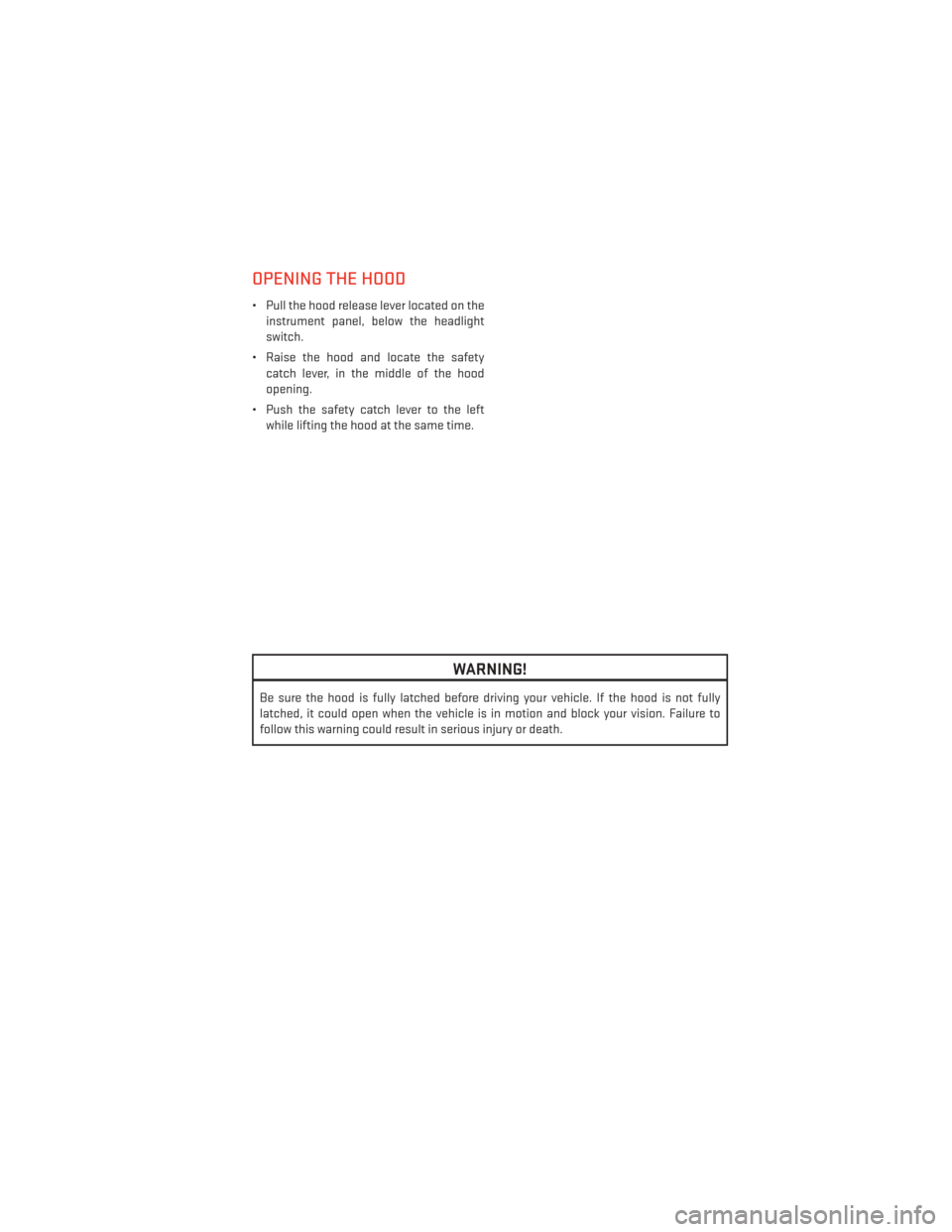
OPENING THE HOOD
• Pull the hood release lever located on theinstrument panel, below the headlight
switch.
• Raise the hood and locate the safety catch lever, in the middle of the hood
opening.
• Push the safety catch lever to the left while lifting the hood at the same time.
WARNING!
Be sure the hood is fully latched before driving your vehicle. If the hood is not fully
latched, it could open when the vehicle is in motion and block your vision. Failure to
follow this warning could result in serious injury or death.
MAINTAINING YOUR VEHICLE
99
Page 102 of 132
FUEL DOOR RELEASE
• The fuel door release button is located inthe driver's door map pocket.
• Push the button once and release to open the fuel door.
Fuel Door Emergency Release
• To manually open the fuel door, remove the cover and pull the release cable lo-
cated in the trunk.
MAINTAINING YOUR VEHICLE
100
Page 103 of 132
Emergency Refueling
• A funnel is provided (located in the trunkin the spare tire area) to open the flapper
door to allow for emergency refueling with
a gas can.
CAUTION!
To avoid fuel spillage and overfilling, do not “top off” the fuel tank after filling.
WARNING!
• Never have any smoking materials lit in or near the vehicle when the fuel door is open
or the tank is being filled.
• Never add fuel when the engine is running. This is in violation of most state and
federal fire regulations and/or local bylaws, and will cause the MIL to turn on.
•
A fire may result if gasoline is pumped into a portable container that is inside of a
vehicle. You could be burned. Always place gas containers on the ground while filling.
MAINTAINING YOUR VEHICLE
101
Page 104 of 132
ENGINE COMPARTMENT3.6L Engine
MAINTAINING YOUR VEHICLE
102
Page 105 of 132
5.7L Engine
MAINTAINING YOUR VEHICLE
103
Page 106 of 132
6.4L Engine (392 HEMI)
MAINTAINING YOUR VEHICLE
104
Page 107 of 132
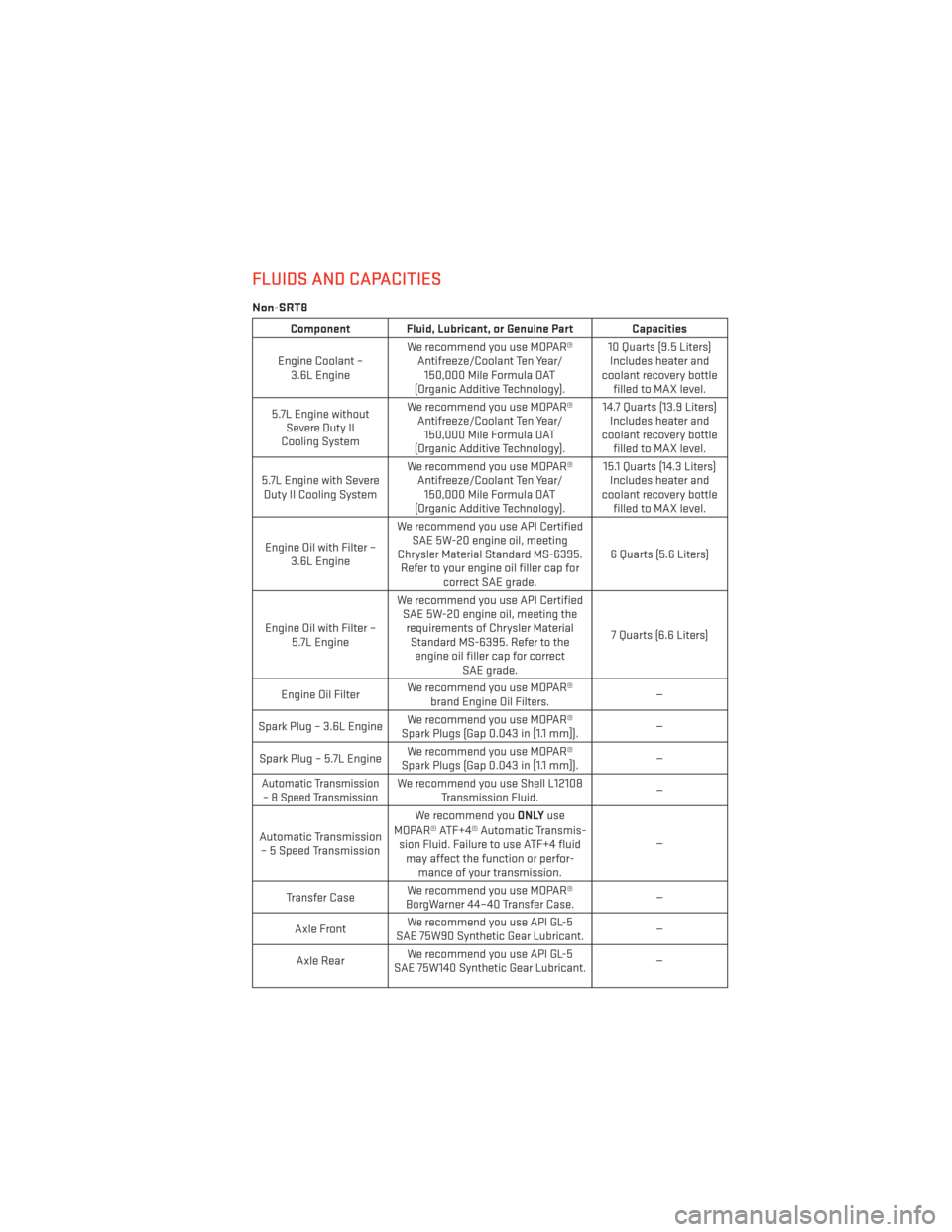
FLUIDS AND CAPACITIES
Non-SRT8
Component Fluid, Lubricant, or Genuine Part Capacities
Engine Coolant – 3.6L Engine We recommend you use MOPAR®
Antifreeze/Coolant Ten Year/150,000 Mile Formula OAT
(Organic Additive Technology). 10 Quarts (9.5 Liters)
Includes heater and
coolant recovery bottle filled to MAX level.
5.7L Engine without Severe Duty II
Cooling System We recommend you use MOPAR®
Antifreeze/Coolant Ten Year/150,000 Mile Formula OAT
(Organic Additive Technology). 14.7 Quarts (13.9 Liters)
Includes heater and
coolant recovery bottle filled to MAX level.
5.7L Engine with Severe Duty II Cooling System We recommend you use MOPAR®
Antifreeze/Coolant Ten Year/150,000 Mile Formula OAT
(Organic Additive Technology). 15.1 Quarts (14.3 Liters)
Includes heater and
coolant recovery bottle filled to MAX level.
Engine Oil with Filter – 3.6L Engine We recommend you use API Certified
SAE 5W-20 engine oil, meeting
Chrysler Material Standard MS-6395. Refer to your engine oil filler cap for correct SAE grade. 6 Quarts (5.6 Liters)
Engine Oil with Filter – 5.7L Engine We recommend you use API Certified
SAE 5W-20 engine oil, meeting therequirements of Chrysler Material Standard MS-6395. Refer to the engine oil filler cap for correct SAE grade. 7 Quarts (6.6 Liters)
Engine Oil Filter We recommend you use MOPAR®
brand Engine Oil Filters. —
Spark Plug – 3.6L Engine We recommend you use MOPAR®
Spark Plugs (Gap 0.043 in [1.1 mm]). —
Spark Plug – 5.7L Engine We recommend you use MOPAR®
Spark Plugs (Gap 0.043 in [1.1 mm]). —
Automatic Transmission
– 8 Speed TransmissionWe recommend you use Shell L12108 Transmission Fluid. —
Automatic Transmission – 5 Speed Transmission We recommend you
ONLYuse
MOPAR® ATF+4® Automatic Transmis- sion Fluid. Failure to use ATF+4 fluid may affect the function or perfor- mance of your transmission. —
Transfer Case We recommend you use MOPAR®
BorgWarner 44–40 Transfer Case. —
Axle Front We recommend you use API GL-5
SAE 75W90 Synthetic Gear Lubricant. —
Axle Rear We recommend you use API GL-5
SAE 75W140 Synthetic Gear Lubricant. —
MAINTAINING YOUR VEHICLE
105
Page 108 of 132
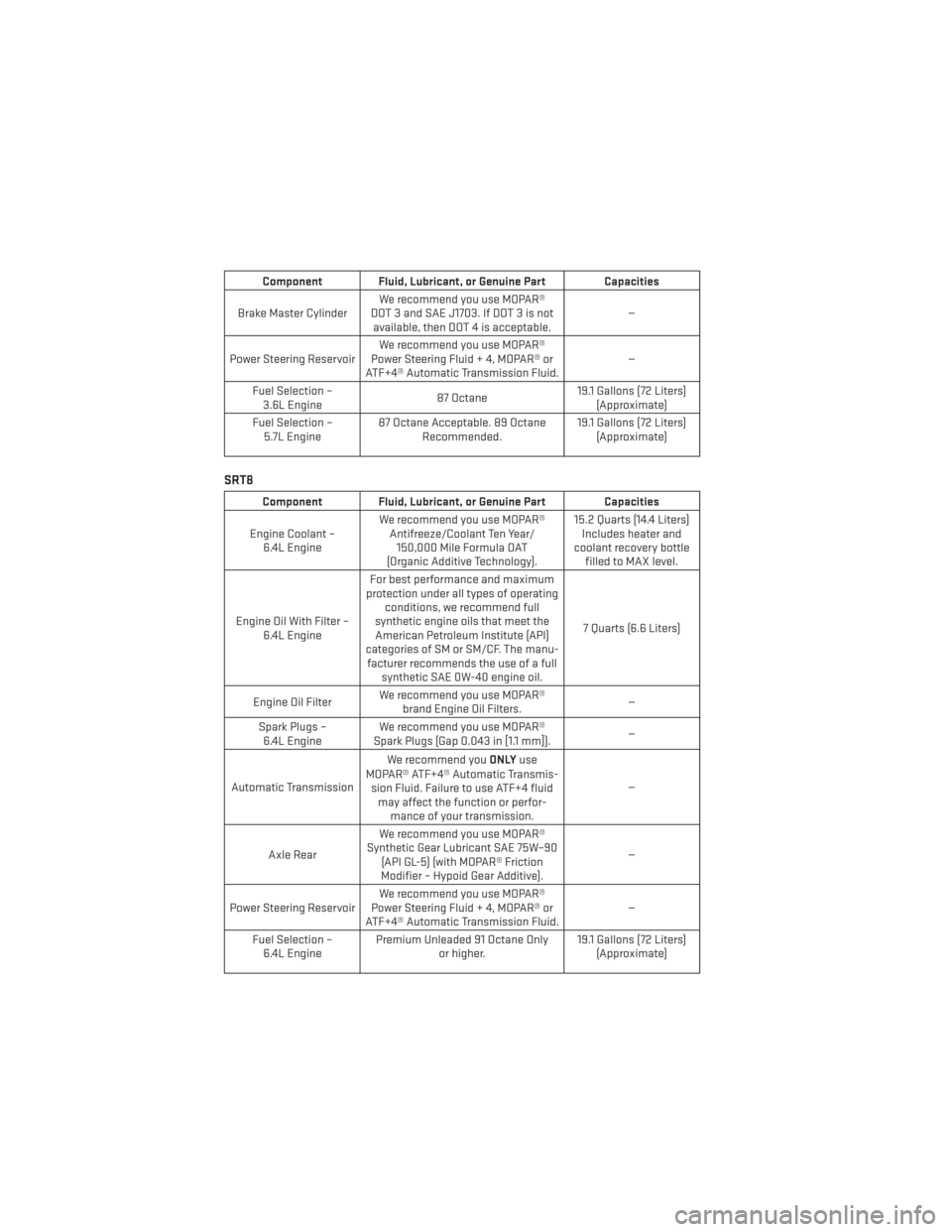
Component Fluid, Lubricant, or Genuine Part Capacities
Brake Master Cylinder We recommend you use MOPAR®
DOT 3 and SAE J1703. If DOT 3 is not available, then DOT 4 is acceptable. —
Power Steering Reservoir We recommend you use MOPAR®
Power Steering Fluid + 4, MOPAR® or
ATF+4® Automatic Transmission Fluid. —
Fuel Selection – 3.6L Engine 87 Octane19.1 Gallons (72 Liters)
(Approximate)
Fuel Selection – 5.7L Engine 87 Octane Acceptable. 89 Octane
Recommended. 19.1 Gallons (72 Liters)
(Approximate)
SRT8
Component Fluid, Lubricant, or Genuine Part Capacities
Engine Coolant – 6.4L Engine We recommend you use MOPAR®
Antifreeze/Coolant Ten Year/150,000 Mile Formula OAT
(Organic Additive Technology). 15.2 Quarts (14.4 Liters)
Includes heater and
coolant recovery bottle filled to MAX level.
Engine Oil With Filter – 6.4L Engine For best performance and maximum
protection under all types of operating conditions, we recommend full
synthetic engine oils that meet the American Petroleum Institute (API)
categories of SM or SM/CF. The manu- facturer recommends the use of a full synthetic SAE 0W-40 engine oil. 7 Quarts (6.6 Liters)
Engine Oil Filter We recommend you use MOPAR®
brand Engine Oil Filters. —
Spark Plugs – 6.4L Engine We recommend you use MOPAR®
Spark Plugs (Gap 0.043 in [1.1 mm]). —
Automatic Transmission We recommend you
ONLYuse
MOPAR® ATF+4® Automatic Transmis- sion Fluid. Failure to use ATF+4 fluid may affect the function or perfor- mance of your transmission. —
Axle Rear We recommend you use MOPAR®
Synthetic Gear Lubricant SAE 75W–90 (API GL-5) (with MOPAR® Friction
Modifier – Hypoid Gear Additive). —
Power Steering Reservoir We recommend you use MOPAR®
Power Steering Fluid + 4, MOPAR® or
ATF+4® Automatic Transmission Fluid. —
Fuel Selection – 6.4L Engine Premium Unleaded 91 Octane Only
or higher. 19.1 Gallons (72 Liters)
(Approximate)
MAINTAINING YOUR VEHICLE
106
Page 109 of 132

CAUTION!
• Mixing of engine coolant (antifreeze) other than specified Organic Additive Technol-ogy (OAT) engine coolant (antifreeze), may result in engine damage and may de-
crease corrosion protection. Organic Additive Technology (OAT) engine coolant is
different and should not be mixed with Hybrid Organic Additive Technology (HOAT)
engine coolant (antifreeze) or any “globally compatible” coolant (antifreeze). If a
non-OAT engine coolant (antifreeze) is introduced into the cooling system in an
emergency, it should be flushed with OAT coolant and replaced with the specified
OAT engine coolant (antifreeze) as soon as possible.
• Do not use water alone or alcohol-based engine coolant (antifreeze) products. Do not
use additional rust inhibitors or antirust products, as they may not be compatible
with the radiator engine coolant and may plug the radiator.
• This vehicle has not been designed for use with propylene glycol-based engine
coolant (antifreeze). Use of propylene glycol-based engine coolant (antifreeze) is not
recommended.
E-85 FLEXIBLE FUEL– (3.6L Engine Only)
• Refer to your Owner's Manual on the DVD for further details.
CAUTION!
Only vehicles with the E-85 fuel filler door label or a yellow gas cap can operate on E-85.
MAINTAINING YOUR VEHICLE
107
Page 110 of 132
MAINTENANCE SCHEDULE
Your vehicle is equipped with an automatic oil change indicator system. The oil change
indicator system will remind you that it is time to take your vehicle in for scheduled
maintenance.
Based on engine operation conditions, the oil change indicator message will illuminate.
This means that service is required for your vehicle. Operating conditions such as frequent
short-trips, trailer tow, extremely hot or cold ambient temperatures, and E85 fuel usage
will influence when the “Change Oil” or “Oil Change Required” message is displayed.
Severe Operating Conditions can cause the change oil message to illuminate as early as
3,500 miles (5,600 km) since last reset. Have your vehicle serviced as soon as possible,
within the next 500 miles (805 km).
On Electronic Vehicle Information Center (EVIC) equipped vehicles, “Oil Change Required”
will be displayed in the EVIC and a single chime will sound, indicating that an oil change is
necessary.
On Non-EVIC equipped vehicles, “Change Oil” will flash in the instrument cluster odometer
and a single chime will sound, indicating that an oil change is necessary.
Your authorized dealer will reset the oil change indicator message after completing the
scheduled oil change. If a scheduled oil change is performed by someone other than your
authorized dealer, the message can be reset by referring to the steps described under
“Electronic Vehicle Information Center (EVIC)/Oil Change Required” in “Understanding Your
Instrument Panel” or under “Instrument Cluster Description/Odometer/Trip Odometer” in
“Understanding Your Instrument Panel” for further information.
NOTE:
Under no circumstances should oil change intervals exceed 10,000 miles (16,000 km) or
twelve months, whichever comes first.
Once A Month Or Before A Long Trip:
• Check engine oil level
• Check windshield washer fluid level
• Check the tire inflation pressures and look for unusual wear or damage
• Check the fluid levels of the coolant reservoir, brake master cylinder, power steering andtransmission as needed
• Check function of all interior and exterior lights
MAINTAINING YOUR VEHICLE
108